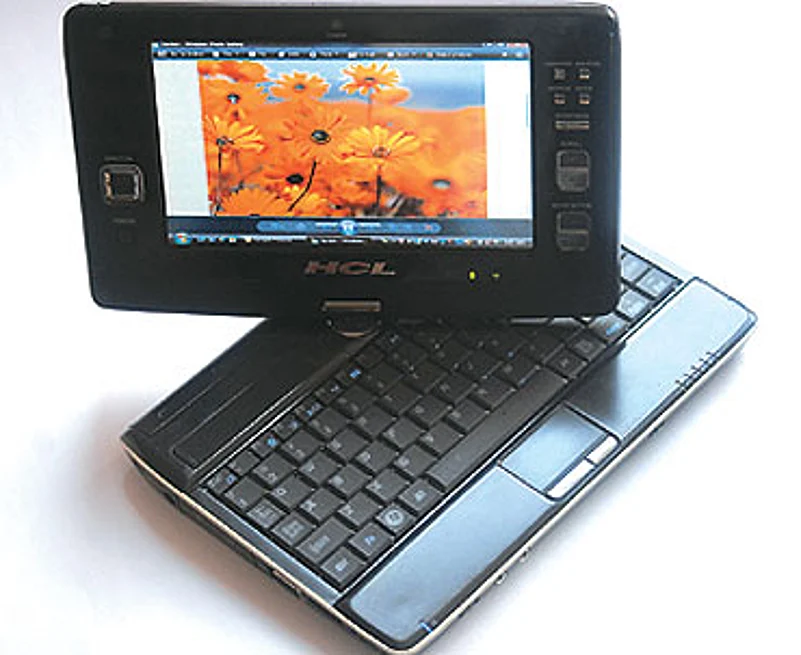Price: Rs 4,900 for the box*
Does not have hard disk to store data. Storage is on the server to which it is connected. Requires constant net connection to work.
Price: Rs 19,000** and Rs 29,900
Ultra portable but small screen restricts usage. Also not very cheap.
Price: Rs 9,990
Launched in 2005 as a fully-functional PC, price shot up when bundled with genuine software
Price: Rs 9,790
Launched with fanfare as People's PC in 2005 but has not made much of a mark. Company now concentrating on component manufacturing.
*Monitor cost extra
**Linux based model available for Rs 13,990
***
Meanwhile, in Delhi, a little gadget resembling a conventional laptop has recently surfaced in the market. HCL's Mileap is a small, ultra-portable laptop with a 7-inch LCD screen. It is priced at around Rs 19,000. Another version, priced at around Rs 29,000, is a mini tablet PC, complete with a swivel screen and a touch interface. Such affordable devices promise to bring the PC closer to the homes of millions of consumers on the wrong side of India's digital divide.
The response from consumers, however, has been muted. Across cities, they prefer the more expensive, "fully loaded" machines. For instance, Shivani's household, one of the early users of the Nova NetPC and part of the company's pilot project in Chennai, is yet to cross the conversion line. The family also has a conventional computer placed right next to the Novatium product. And in the parts of Delhi where the product was introduced in September last year, there has been, at best, a lukewarm acceptance of the concept.
The verdict is clear: Indian users are not ready to accept a product stripped of all features. They want everything in their machine, even at a higher price. Evidently, earlier attempts by companies at developing low-cost computers have not worked well in India. In 2005, HCL had launched a "PC for India", the first to break the Rs 10,000 price barrier. Launched with fanfare by then IT minister Dayanidhi Maran, this was the closest to being a full-feature computer for a mere Rs 9,990. The same year, Calcutta-based Xenitis Computers launched the My PC project at a lower Rs 9,790. Both initiatives have faded into the horizon. While HCL is now busy with its MiLeap offering, Xenitis has shifted focus to component manufacturing.
Sure, some companies also tried using cheaper Chinese components to break the price barrier, but there were few takers among India's quality-conscious computer users. Even for the few who were willing to accept it, the low volumes did not make business sense. Says Sameer Kochar, MD, Skoch Development Foundation: "There is a niche segment which wants the stunted products but there are not enough volumes for companies to push them for long."
Experts feel the poor response to low-priced products stems from people's aspiration to have feature-laden products even if they don't need it. Says IT and telecom expert Mahesh Uppal: "A low-cost PC is just short of what most people would need. People have aspirations regarding what they want from a PC. If you strip down that product, that aspiration is not fulfilled." Kochar agrees: "People always look at full functionality and you cannot fulfil aspirations in a stunted model. I don't know who they are targeting."

The HCL MiLeap laptop
For instance, Novatium's NetPC has limited storage capability, and requires a constant and robust internet connection to function—considering the state of India's connectivity in rural areas and Tier-II and Tier-III cities, this can be serious handicap. Then, HCL's MiLeap is limited by its screen size, which is a tad bigger than a smart phone.
Novatium CEO Alok Singh disagrees. "If a PC has to go to the millions, it has to get into the position of an appliance where users need not worry about software, virus or memory. They should be able to just switch it on and use it," he says. Ashok Jhunjhunwala of iit Madras—who has been working on a low-cost computer and was one of the brains behind Novatium's product—agrees: "We need to integrate the computer, the internet and applications to make PCs household devices rather than just giving them to the people in a fragmented manner. And this needs to be done at an affordable price."
Most consumers agree that low-cost models indeed do not fulfil their aspirations for a complete product. Today, every buyer wants a dvd drive and good speakers in their PC. Says former Nasscom president Kiran Karnik: "The trade-off between performance and price has to be just right. The models that have come out so far have not quite achieved that. There is a tipping point in terms of consumer perception of value-for-money, as we have seen in mobile handsets and colour TV. The 'low-cost' PC is yet to hit that sweet spot."
Furthermore, aggressive pricing by existing players has belittled the low-cost status of many of these products. The HCL MiLeap's Y series, for instance, is slightly more expensive than an average desktop. An assembled machine is even cheaper. With component costs falling, the price difference between the MiLeap and conventional laptops has thinned. Obviously, people are ready to go that extra step to get the real thing. The user also thinks of the total cost, which includes hardware, software, maintenance and connectivity. Taken as a whole, these are yet too high for large-scale penetration. The NetPC charges users Rs 399 a month for the service; the user also has to pay for the monitor.
It must be said here that the government has fallen short in its role to push affordable alternatives. Says Ajai Chowdhry, chairman and CEO, HCL Infosystems: "In India, increasing PC penetration on a mission mode never happened. The concept of connecting GDP with PC penetration is absent. The governments of Brazil, Korea and Singapore thought of that." Karnik adds: "Greater government involvement through funding of design/R&D is desirable. Project/funding for engineering and development of a sub-Rs 10,000 PC should be given to two-three companies or consortia, ideally academia, R&D institutions and companies." Clearly, that never happened.
What has happened though is a shift towards mobile phones, which are today performing most of the functions of computers. With feature-rich gadgets like the Blackberry and smart phones coming in, many computer applications like e-mail and surfing have shifted to the hand phone. Says Uppal: "While phones would do most of the computer work, people with bigger needs would gradually access shared PCs. I myself am carrying my laptop much less these days."
And here lies a possible solution. According to official data, most of India's targeted internet users used the mobile phone as their access device in recent months. With applications and features going mobile, and with no problems of connectivity even in remote areas, mobile phones could provide the answer to India's much-needed low-cost computer.






















